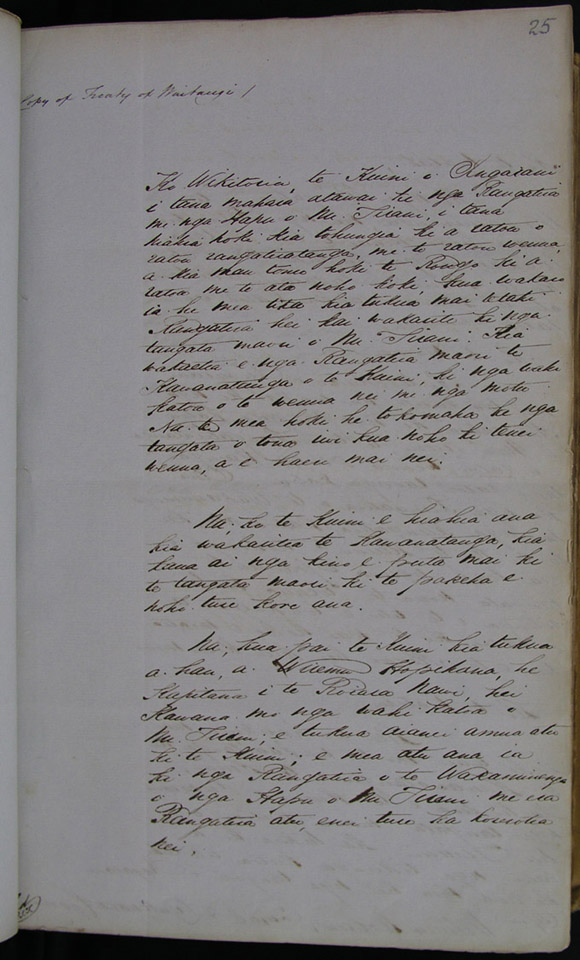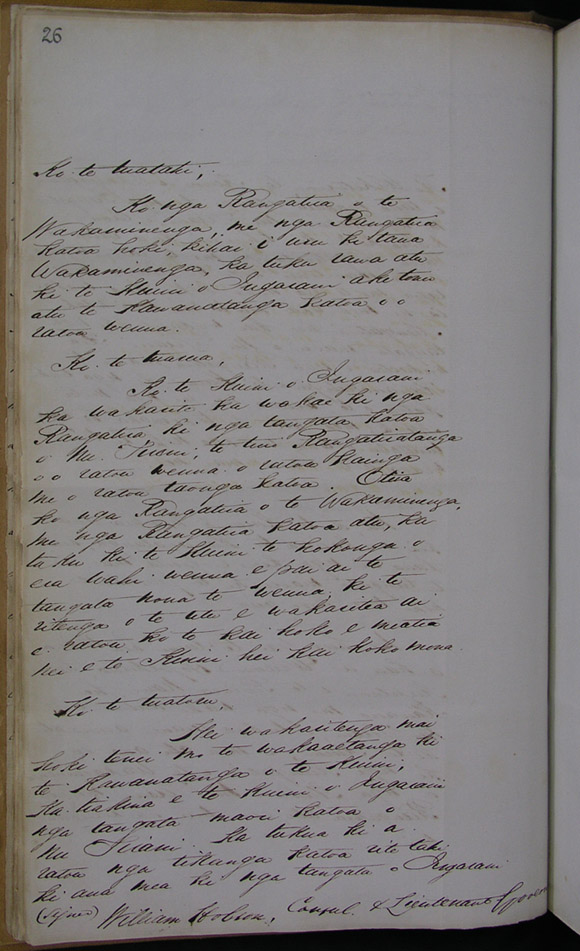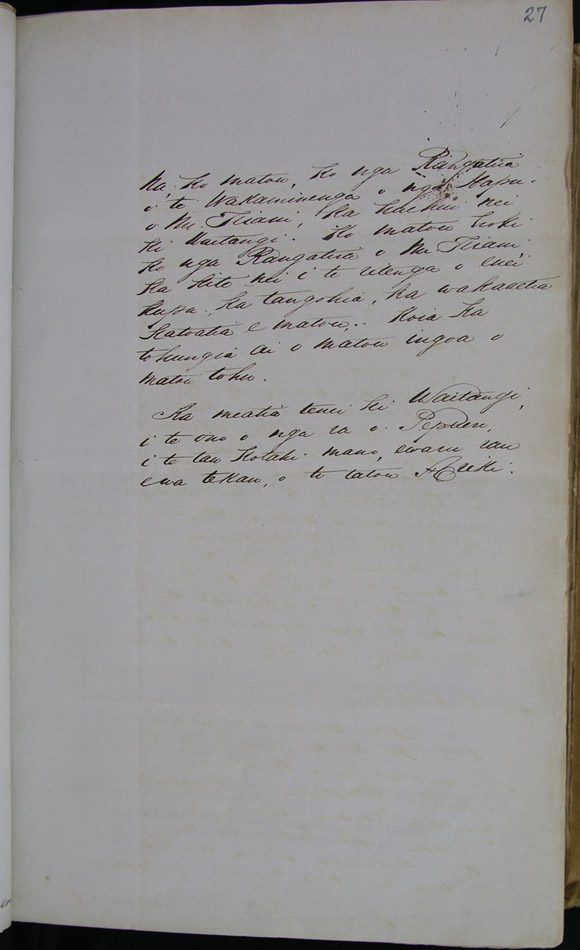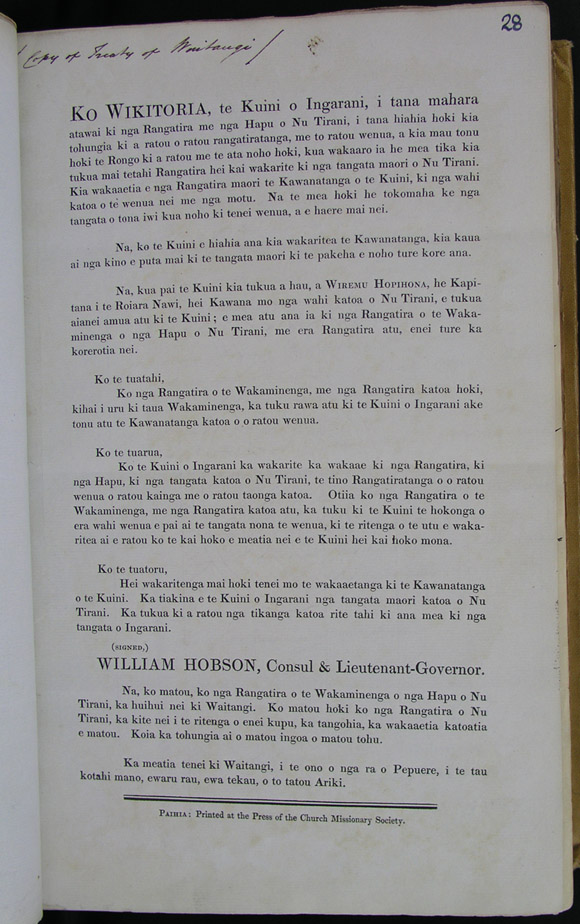THE SO-CALLED "CERTIFIED COPY"
Even before the ink was dry on the Tiriti O Waitangi signed by the chiefs on February 6th 1840, James Stuart Freeman had manufactured one of his composite "Royal Style" treaty versions in English from the rough draft notes. This he despatched to Governor Sir George Gipps on the 8th of February aboard the store ship, Samuel Winter, which sailed on the midday tide. Freeman did the same two weeks later on the 21st of February, when he sent his (much vaunted by the modern grievance industry) "Certified Copy" to Gipps in a despatch carried aboard the Martha. In a letter section to Gipps placed at the tail end of the same piece of paper, Freeman made provision for Reverend Williams to "certify" the accuracy of his Maori translation, which was being sent in the same despatch.Here's Freeman's "Royal style" English text, which he created by taking bits and pieces from the early draft notes and stringing them together with linking text.
Her Majesty Victoria Queen of the United Kingdom of Great Britain and Ireland regarding with Her Royal Favour the Native Chiefs and Tribes of New Zealand and anxious to protect their just Rights and Property and to secure to them the enjoyment of Peace and Good Order has deemed it necessary in consequence of the great number of Her Majesty's Subjects who have already settled in New Zealand and the rapid extension of Emigration both from Europe and Australia which is still in progress to constitute and appoint a functionary properly authorized to treat with the Aborigines of New Zealand for the recognition of Her Majesty's Sovereign authority over the whole or any part of those islands. Her Majesty therefore being desirous to establish a settled form of Civil Government with a view to avert the evil consequences which must result from the absence of the necessary Laws and Institutions alike to the native population and to Her subjects has been graciously pleased to empower and to authorize "me William Hobson a Captain" in Her Majesty's Royal Navy Consul and Lieutenant Governor of such parts of New Zealand as may be or hereafter shall be ceded to Her Majesty to invite the confederated and independent Chiefs of New Zealand to concur in the following Articles and Conditions.
ARTICLE THE FIRST
The Chiefs of the Confederation of the United Tribes of New Zealand and the separate and independent Chiefs who have not become members of the Confederation cede to Her Majesty the Queen of England absolutely and without reservation all the rights and powers of Sovereignty which the said Confederation or Individual Chiefs respectively exercise or possess, or may be supposed to exercise or to possess, over their respective Territories as the sole Sovereigns thereof.
ARTICLE THE SECOND
Her Majesty the Queen of England confirms and guarantees to the Chiefs and Tribes of New Zealand and to the respective families and individuals thereof the full exclusive and undisturbed possession of their Lands and Estates Forests Fisheries and other properties which they may collectively or individually possess so long as it is their wish and desire to retain the same in their possession; but the Chiefs of the United Tribes and the individual Chiefs yield to Her Majesty the exclusive right of Pre-emption over such lands as the proprietors thereof may be disposed to alienate at such prices as may be agreed upon between the respective Proprietors and persons appointed by Her Majesty to treat with them in that behalf.
ARTICLE THE THIRD
In consideration thereof Her Majesty the Queen of England extends to the Natives of New Zealand Her royal protection and imparts to them all the Rights and Privileges of British Subjects.
[Signed] W Hobson Lieutenant Governor
Now therefore We the Chiefs of the Confederation of the United Tribes of New Zealand being assembled in Congress at Victoria in Waitangi and We the Separate and Independent Chiefs of New Zealand claiming authority over the Tribes and Territories which are specified after our respective names, having been made fully to understand the Provisions of the foregoing Treaty, accept and enter into the same in the full spirit and meaning thereof in witness of which we have attached our signatures or marks at the places and the dates respectively specified.
Done at Waitangi this Sixth day of February in the year of Our Lord one thousand eight hundred and forty.
Freeman then used available space on the last page to tell Gipps he would include, within the same enclosure, the names of 52 signatory chiefs at Waitangi and an additional 78 names received at Hokianga in the previous week. These signatures were appended as separate documents to Freeman's Royal style sheets. One of the appended documents included was Reverend Henry Williams' printed Tiriti O Waitangi translation. The entire enclosure, containing all treaty related documents and letters or reports, was then initialled by Hobson at the top left hand corner of Freeman's Royal style document. Freeman also wrote "Copy of the treaty" at the top left of Reverend Williams' printed Maori translation. Two weeks previously he'd done the same when Reverend Williams sent a handwritten Maori copy to Gipps and on that occasion Freeman initialled the Maori text with JSF at the bottom left hand corner.
In this separate letter or information section beyond his Royal style English treaty version to Gipps, Freeman wrote:
Here follow the signatures of 52 Chiefs, given at Waitangi on the sixth of February 1840: and the signatures of 78 chiefs given at Hokianga on the 12th of that month.
This was followed by yet another clause, written by Freeman, wherein Reverend Williams was called upon to certify his Maori translation.
I certify that the above is as literal a translation of the Treaty of Waitangi as the Idiom of the Language will admit of.
Henry Williams.
In 1972, about 20-years before the Littlewood Treaty came back into the public arena, historian Ruth Ross listed the various (and variable) treaty versions despatched overseas and, in her paper, included a preliminary qualifying statement:
'These were enclosures in the following despatches (except in the parentheses in (d), page references are to the English versions, not to the despatches in which they are enclosed):
(a) Hobson to Gipps, 5-6 February 1840, of which a copy was enclosed in Gipps to Secretary of State, 19 February 1840 CO 209/6, pp. 52-54 and printed in GBPP, 1840, XXXIII, 560, pp. 10-11. (CO 209 is on microfilm, National Archives, Wellington).
(b) Hobson to Secretary of State, 40/1 of 17 February 1840, CO 209/7, pp. 13-14[v]; in the printed version, this despatch is dated 16 February. GBPP, 1841, XVII. 311, p. 10.
(c) Duplicate (dated 16 February 1840) of 40/1, G 30/1, pp. 29-32, National Archives, Wellington.
(d) Duplicate of Hobson to Secretary of State, 40/3 of 23 May 1840, G 30/1, pp. 75-78. (The original of 40/3 dated 25 May did not enclose an English version - see CO 209/7, pp. 55-64).
(e) Hobson to Secretary of State, 40/7 of 15 October 1840, CO 209/7, p. 178, printed GBPP, 1841, XVII, 311, pp. 98-99, where it is headed 'Translation' and follows the Maori text, which is headed 'Treaty'. But in the original 'certified copy of the Treaty both in the English and Native language' on CO 209/7, p. 178, the heading 'Treaty' applies to both English and Maori texts.
Ruth Ross then makes the following observation:
From the very beginning, confusion has reigned over what was the translation for which. For this Henry Williams himself was initially responsible. The English version forwarded with Hobson's first New Zealand despatch to the Secretary of State was endorsed by Williams: I certify that the above is as Literal a translation of the Treaty of Waitangi as the idiom of Language will admit of''. Yet this is palpably incorrect; Williams knew better than anyone else that the Treaty of Waitangi was a translation of an English draft, not vice versa.
Here, Ruth Ross is confused about what Reverend Williams has certified, possibly because she didn't know that a printed Maori copy was sent in the same enclosure. This fact is not known to many of our historians, as the Maori copies were, seemingly, taken out of the despatches and filed away separately. They don't show up on any of the microfilms and, seemingly, few historians know or will acknowledge that 4 Maori copies (1 handwritten by Williams and 3 printed) were repatriated from the Colonial Office archives in Britain to New Zealand sometime in the 1940's. All were sent overseas in February 1840 to Gipps and Normanby. They are now found in Vol. 30/1 at the National Archives in Wellington, NZ.
Ruth Ross continues:
From the facts available it is apparent that what was given to Williams to translate about 4 p.m. on 4 February was a composite version of the draft notes of Hobson, Freeman and Busby. Whether this composite text was compiled by Hobson, or by his secretary or was their joint effort, it cannot have been put together until after Busby's draft articles had been 'submitted to Capt. Hobson' sometime on 3 February. The existence of a number of other English versions, all of them composite versions of the same draft notes, suggests a certain element of chance, as well as haste, in the compilation and selection of the version actually handed over for translation. That these other composite texts were afterwards forwarded at various times to Hobson's superiors, in each instance as though the text in question had official status - that is, was either a translation of the treaty, or the text from which the treaty had been translated - suggests a considerable degree of carelessness, or cynicism, in the whole process of treaty making (See Te Tiriti O Waitangi - Texts and Translations, by Ruth Ross, New Zealand Journal of History, 1972).
Ruth Ross speaks of the final draft created after Busby's 3rd of February 1840 text. We have always had the 3rd of February text on hand, but, as every treaty historian knows, the 4th of February 1840 text went missing. It remained lost until 1989, when it was rediscovered amongst family papers at Pukekohe, NZ.
Ruth Ross is bewildered by references to so-called "certified copy" of the treaty and makes mention of Williams' strange, signed endorsement at the end, which says:
"I certify that the above is as Literal a translation of the Treaty of Waitangi as the idiom of Language will admit of''.
She then adds:
'Yet this is palpably incorrect; Williams knew better than anyone else that the Treaty of Waitangi was a translation of an English draft, not vice versa'.
In 1972 when Ross was trying to fathom this incomprehensible mess, she had to conclude:
'A comparison of all five English versions with the Maori text makes it clear that the Maori text was not a translation of any one of these English versions, nor was any of the English versions a translation of the Maori text'.
Had Ruth Ross lived to see the Littlewood Treaty (Busby's final draft) come back into the public arena or had she the opportunity to compare its wording to both the Clendon and Wilkes' despatches, then she would have, undoubtedly, understood how all the treaty related confusion was ushered in by the loss of the final English draft.
But let's look at Reverend Henry Williams' so-called "certified copy" of the treaty and further weigh in the balance the notion that he is certifying Freeman's ad hoc composite version in English. Why would Williams endorse such wording when, as Ruth Ross observes, it is nothing like his Maori translation?
Whereas the lingering impression left by our historians is that Williams personally wrote out this entire copy then certified it, the truth is that the text was fully handwritten by James Stuart Freeman. The only contribution that Reverend Henry Williams made to this document was to sign his name in the space provided by Freeman. Let's look at the final section of the 4-page document.
The final page of what has come to be known as, in grievance industry vernacular, the so-called "certified copy" of the Treaty of Waitangi. In the letter section penned by Freeman at the end of the document, Reverend Henry Williams is called upon to certify his TRANSLATION as being "as literal a TRANSLATION of the Treaty of Waitangi as the idiom of language will admit of". Along with the 130 signatures of chiefs appended to Freeman's "Royal Style" English treaty version, a Maori TRANSLATION document was also included. The appended, printed Maori Tiriti version that went in the same enclosure is what Williams was "certifying" in the space allotted and designated by Freeman. The large despatch of documents, including Freeman's "Royal Style" English treaty document and Williams' certified TRANSLATION, was not despatched until the 21st of February 1840 aboard the "Martha". Because of a steady E.S.E. wind, the Herald and the Martha were both locked in the harbour of the Bay of Islands until the wind abated.Felton Mathew's letter to Sarah Mathew states:
'Tuesday 18th Feby 1840. Yesterday dear Sarah I wrote you a few lines by the Martha, which is to sail tomorrow morning: expecting that ere this, we should have been on our way to the Thames. It however has blown all day from the ESE...Here we must lie until the weather moderates.' (See: The unpublished journal of Felton Mathew, Special Collections, Auckland Public Library).
As it turns out, the Martha didn't manage to get away from the harbour until the 21st and Hobson's final, completed despatches weren't put aboard the Martha until the night of the 20th of February 1840.
So, what was Reverend Henry Williams certifying? It was certainly not the English text shown, in part, above, as he was never its author. His function in the treaty drafting incentive was to act as official translator. All he could ever certify was the "work" that he had undertaken in behalf of the government. He was called upon to assure all concerned that his "translation" of the finalised English text, handed to him at 4 p.m. on the afternoon of the 4th of February 1840, was as close "as the idiom of language would admit of".
James Stuart Freeman, as stated, wrote the above English treaty document on the 17th of February 1840. On this same day Reverend William Colenso printed 200 "official" copies of the Tiriti O Waitangi, based solely on the translation into Maori supplied by Reverend Henry Williams and his son, Edward. On this same day Hobson and/ or other members of the government made a treaty presentation to chief Pomaré II, with James Reddy Clendon in attendance. Clendon, whose estate sat adjacent to the PA of chief Pomaré II, signed in behalf of the chief then added his own witnessing signature and the date.
James Reddy Clendon wasted no time in sending his despatch No. 6 to the U.S. Secretary of State, John Forsyth, once he had the printed Maori copy of the treaty. He had obviously been waiting for this printing event, such that he had sufficient documentation to make a complete despatch.With regards to the two very large despatches that Hobson put together between about the 16th and 20th of February 1840, our historians have left the impression that he didn't send even one printed copy of the Maori Tiriti O Waitangi overseas. Because of an unfavourable wind blowing onto the entrance of the harbour, Hobson was locked in a stalemate and couldn't get away to the Thames in H.M.S. Herald on the day appointed. He took advantage of the available extra time to prepare two large despatches, one for Lord Normanby in England and another for Governor Sir George Gipps in Australia. In Hobson's letter of the 20th of February 1840 he stated to Lord Normanby:
'The enclosed copies of letters that I have had the honour to address to his Excellency, Sir George Gipps, will put your Lordship in possession of the whole of my proceedings since my landing in New Zealand'.
One very important part of his "proceedings" had been the printing events of Proclamations and Te Tiriti O Waitangi*. These demonstrated the competence of Hobson to his superiors and he was obliged to forward both handwritten and printed versions of the Maori Tiriti O Waitangi for placement within the Australian or British Parliamentary records.
Problems can arise in the correct interpretation of events if our historians are too superficial in their analysis and don't probe deep enough into the extant documented evidence. In their representations before the public as to what constitutes the "Certified Copy" or, indeed, what Reverend Henry Williams was actually putting his signature to, our historians couldn't be more wrong in claiming that he was endorsing Freeman's English wording. The item "above", which Williams guaranteed the accuracy of in Freeman's qualifying clause, was a Maori version copy of the Treaty of Waitangi (Te Tiriti O Waitangi) appended to and included within the enclosure. Freeman mentions other items to be appended in another statement written above.
As Ruth Ross pointed out so eloquently in 1972, there is a major problem with the general conclusion adhered to by establishment historians, as 'A comparison of all five English versions with the Maori text makes it clear that the Maori text was not a translation of any one of these English versions'. Williams had used some other, now missing, final draft, handed to him on the 4th of February 1840 and with it had achieved 'as Literal a translation of the Treaty of Waitangi as the idiom of Language will admit of'.
As stated, the Maori version documents, from 3 February despatches, do still exist within a beautifully bound volume at the National Archives of New Zealand, titled, Repatriated Despatches, G-30/1. Within this thick volume can be found the "original" handwritten or printed Maori texts that were sent to both Sir George Gipps in N.S.W Australia or to Lord Normanby in London, England on the 8th and 21st of February 1840. Yet other despatched original documents can be found in the volume G-36/1.
Let's look at Reverend Henry Williams' true "Certified Treaty"…the one (in either handwritten or printed form) he, as official TRANSLATOR, was actually putting his signature to in the space provided by James Stuart Freeman:
The single line of writing at the very top of the first page (pg. 25 of Vol. G-30/1) is in the hand of James Stuart Freeman, who has also initialled the page in the bottom left hand corner. Otherwise, the entire document of Maori Treaty text is in the handwriting of Reverend Henry Williams. This 3-page document is, essentially, the true "Certified Copy" text that Williams was referring to and constitutes the TRANSLATION wording he "signed off" as official 'TRANSLATOR". The handwritten copy shown was sent to Gipps on the 8th of February 1840, followed by a printed copy two weeks later. In all, three printed Maori versions were sent overseas in the 3rd week of February (1 to Gipps and 2 to Normanby) in the double despatches assembled between the 16th and 20th of February 1840.It's unfortunate that Freeman did not have the foresight to write the qualifying statement: "I certify that the above is as Literal a translation of the Treaty of Waitangi as the idiom of Language will admit of'' on either this handwritten Maori text sheet by Williams or onto the three printed Maori copies despatched on the 21st of February, rather than at the bottom of his own "Royal Style" English copy. In that age of innocence, no one could predict the machinations of a "grievance industry" 140-years into the future (see Volume G-30/1, pp. 25-27, National Archives of New Zealand, Wellington).
This is a photograph of the original printed Maori Treaty sent to Governor Sir George Gipps in N.S.W. Australia on the 21st of February 1840. In a very literal sense, this is the "certified" Maori text translation to which both James Stuart Freeman and Reverend Henry Williams were referring directly. Reverend Henry Williams' signed attestation referred only to this document, which was the TRANSLATION he'd created, based upon the finalised English draft he'd been given to translate into Maori at 4 p.m. on the 4th of February 1840.
These two printed Maori version sheets were despatched to Lord Normanby on the 21st of February 1840. They went to Australia aboard the Martha, whereupon Hobson's direct despatch to Normanby was transferred to H.M.S Achilles. The materials went by way of "De Janeiro" (Brazil) and onward to Britain, arriving at the Colonial Office in London on September 28th 1840.



